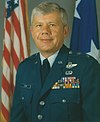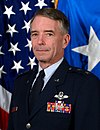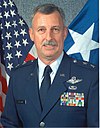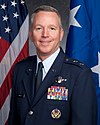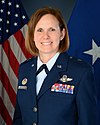Tenth Air Force
| Tenth Air Force | |
|---|---|
World War II - Asiatic-Pacific Theater
| |
| Decorations | Air Force Outstanding Unit Award |
| Commanders | |
| Commanding officer | Brig Gen Regina A. Sabric |
| Command chief | CMSgt Christopher S. Bluto Jr. |
| Notable commanders | Lewis H. Brereton |
The Tenth Air Force (10 AF) is a unit of the
The command directs the activities of 14,000 Air Force Reservists and 950 civilians located at 30 military installations throughout the United States. 10 AF is the AFRC numbered air force whose units and aircraft are primarily gained by the Combat Air Forces (CAF), specifically
Tenth Air Force was a
The 10th Air Force is commanded by Maj Gen Bryan P. Radliff.
Overview
Tenth Air Force, located at Naval Air Station Fort Worth Joint Reserve Base, Texas, directs the activities of nearly 16,000 reservists and 636 civilians located at 31 military installations throughout the United States. The mission of Tenth Air Force is to exercise command supervision of its assigned Reserve units to ensure they maintain the highest combat capability to augment active forces in support of national objectives.
With approximately 60 full-time headquarters staff members, Tenth Air Force acts as the focal point for all matters pertaining to assigned Air Force Reserve units and individuals. With the assistance of 36 traditional reservists assigned, the headquarters monitors and provides assistance to all subordinate units to help resolve problem areas and more efficiently maintain unit combat readiness.
The headquarters is responsible for managing and supervising five fighter wings comprising eleven fighter squadrons and seven fighter groups; one rescue wing comprising six air rescue squadrons in two groups; one bomb wing; one airborne warning and control group; one special operations wing; one space wing comprising nine squadrons; one regional support group; and more than seventy non-flying units.
If mobilized, the flying units with custody of their own aircraft and their support elements would be gained by
The flying organizations within Tenth Air Force include fighter units equipped with the
Other organizations include combat air operations, medical, civil engineer, combat logistics, communications, security forces, aerial port, intelligence and aeromedical units. Additionally, the Reserve portion of the Air National Guard/Air Force Reserve Test Center (AATC), which conducts operational test and evaluation of fighter equipment and improvements, is directly assigned to Tenth Air Force.
Reservists from 10th Air Force units are routinely deployed to Air Expeditionary units in combat areas of Central and Southwest Asia as part of the
Units
Operational units of Tenth Air Force are:[2]
- Combat Air Forces
- Tyndall AFB, Florida
- NAS JRB Fort Worth, Texas
- Barksdale AFB, Louisiana
- Seymour Johnson AFB, North Carolina
- Hill AFB, Utah
- Whiteman AFB, Missouri
- Elmendorf AFB, Alaska
- 482d Fighter Wing – Homestead ARB, Florida
- Eglin AFB Aux Field No. 3 / Duke Field, Florida
- 920th Rescue Wing – Patrick Space Force Base, Florida
- Davis-Monthan AFB, Arizona
- Creech AFB, Nevada
- Davis-Monthan AFB, Arizona
- 655th ISR Group - Wright-Patterson AFB, Ohio
- Regional Support Groups
- NAS JRB Fort Worth, Texas
- Space Forces
- Schriever AFB, Colorado
- Pilot Training Forces
- Luke AFB, Arizona
- Command/Control Forces
- Tinker AFB, Oklahoma
Tenth Air Force Squadrons, Flights, and Operational Locations are also stationed at:
|
|
History
World War II
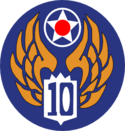
Tenth Air Force was constituted on 4 February 1942 and activated on 12 February, built up around a nucleus of air force personnel newly arrived from
The Tenth Air Force initially provided control of all USAAF combat operations in the
Under General
In March 1943 the China Air Task Force was dissolved and its components made part of the new
The Tenth Air Force conducted offensive strategic bombing operations in Burma and Thailand and supported Allied ground efforts with close air support and operations against Japanese communications and supply installations. After the end of the war in China, the command headquarters departed from Shanghai on 15 December 1945, being attached to Army Service Forces at Fort Lawton, Washington, where the last personnel were demobilized and the command inactivated, being returned to HQ USAAF on 6 January 1946.
Air Defense Command
In March 1946, USAAF Chief General
The command was re-activated on 24 May 1946 at
The
In addition to the command and control of the active Air Force interceptor and radar units in its region, it also became the command organization for the Air Force Reserve and state Air National Guard units. By 1949 with the establishment of the Western Air Defense Force (WADF) and Eastern Air Defense Force (EADF), the air defense mission of the command was transferred to WADF, leaving Tenth AF free to focus on its reserve training tasks.
Moved to
Tenth Air Force was reactivated on 20 January 1966, at
On 16 January 1968 Air Defense Command was re-designated Aerospace Defense Command (ADCOM) as part of a restructuring of USAF air defense forces. Tenth Air Force's second period of service was short lived, however, and the command was again inactivated as the result of a major ADCOM reorganization on 31 December 1969 of the First Fourth, Tenth Air Forces and several Air Divisions. This reorganization was the result of the need to eliminate intermediate levels of command in ADCOM driven by budget reductions and a perceived lessening of the need for continental air defense against attacking Soviet aircraft.
ADCOM reassigned the units under the inactivated Tenth Air Force primarily to the 14th, 23d and 24th Air Divisions.
Air Force Reserve
Continental Air Command was discontinued on 1 August 1968, and was replaced by Headquarters Air Force Reserve, located at
When Air Force operations were phased out of Ellington AFB, Central Region Headquarters moved to
As a result, the unit assumed command over all Tactical Air Command-gained and Strategic Air Command-gained Air Force Reserve units regardless of geographic location. With the inactivation of TAC and SAC in 1992, Tenth Air Force today is responsible for command supervision of fighter, bomber, rescue, airborne warning and control, special operations, flying training, combat air operations battle staff, and space reserve units.
Lineage
- Established as 10th Air Force on 4 February 1942.
- Activated on 12 February 1942
- Redesignated Tenth Air Force on 18 September 1942
- Inactivated on 6 January 1946
- Activated on 24 May 1946
- Discontinued, and inactivated, on 1 September 1960
- Activated on 20 January 1966
- Organized on 1 April 1966
- Inactivated on 31 December 1969
- Redesignated Tenth Air Force (Reserve) on 24 September 1976
- Activated on 8 October 1976
- Redesignated Tenth Air Force on 1 December 1985
Assignments
- Air Force Combat Command, 12 February 1942
- U.S. Army Forces in China-Burma-India Theater, 5 March 1942
- Army Air Forces, India-Burma Sector, 21 August 1943
- Attached to Eastern Air Command, 15 December 1943 – 1 June 1945
- Further attached to Strategic Air Force, Eastern Air Command, 15 December 1943 – 20 June 1944
- Army Air Forces, India-Burma Theater, 27 October 1944
- Army Air Forces, China Theater, 6 July 1945
- U.S. Army Air Forces, China Theater, 25 August 1945
- Army Service Forces, Seattle Port of Embarkation, 5–6 January 1946
- Air Defense Command, 24 May 1946
- Continental Air Command, 1 December 1948 – 1 September 1960
- Air (later, Aerospace) Defense Command, 20 January 1966 – 31 December 1969
- Air Force Reserve (later, Air Force Reserve Command), 8 October 1976 – present
Components
Commands
- IX Air Service Area: 19 March – 1 July 1948, assigned to Tenth Air Force, 19 March – 1 July 1948
- X Air Force Service Command, assigned from 1 February – 20 August 1943. Activated 1 May 1942 with headquarters at New Delhi, India. Brigadier General Elmer E. Adler was appointed commanding officer. 10 AFSC was redesignated China-Burma-India Air Service Command on 20 August 1943.[5]
- XXI Air Force Service: 19 March – 1 July 1948
- Karachi American Air Base: 13 February – 20 August 1943
Air Divisions
|
|
District
- 2 Air Reserve: 1 December 1951 – 1 April 1954.
Regions
- Fourth Air Force Reserve: 1 Jul – 1 September 1960
- Fifth Air Force Reserve: 1 Jul – 1 September 1960
Wings and groups
- 552d Airborne Early Warning and Control Wing, 15 September – 15 November 1969
- 4780th Air Defense Wing (Training), 1 July 1968 – 15 November 1969
- 12th Bombardment Group, c. 21 March 1944 - c. 24 January 1945[6]
- 341st Bombardment Group, 15 September 1942 - 3 October 1942, then resubordinated to the India Air Task Force; then reassigned back to Tenth Air Force on 16 October 1943.
Stations
|
|
List of commanders
| No. | Commander | Term | |||
|---|---|---|---|---|---|
| Portrait | Name | Took office | Left office | Term length | |
| 1 | Major General Roger P. Scheer | 1 December 1985 | 1 November 1986 | 335 days | |
| 2 | Brigadier General William B. McDaniel | 1 November 1986 | 6 July 1987 | 247 days | |
| 3 | Brigadier General John J. Closner III | 6 July 1987 | 5 July 1989 | 1 year, 364 days | |
| 4 | Brigadier General Robert A. McIntosh | 5 July 1989 | 1 December 1990 | 1 year, 149 days | |
| 5 | Major General David R. Smith | 1 December 1990 | February 1998 | ~7 years, 62 days | |
| 6 | Major General John A. Bradley | February 1998 | 4 March 2002 | ~4 years, 31 days | |
| 7 | Major General David E. Tanzi | 4 March 2002 | 20 January 2005 | 2 years, 322 days | |
| 8 | Major General Allan R. Poulin | 20 January 2005 | 24 December 2005 | 338 days | |
| 9 | Major General Richard C. Collins | 24 December 2005 | 3 June 2007 | 1 year, 161 days | |
| 10 | Major General Thomas R. Coon | 3 June 2007 | May 2009 | ~1 year, 332 days | |
| 11 | Major General Frank J. Padilla | May 2009 | 5 November 2011 | ~2 years, 188 days | |
| 12 | Major General William B. Binger | 5 November 2011 | 18 October 2014 | 2 years, 347 days | |
| 13 | Major General Richard W. Scobee | 18 October 2014 | 1 May 2017 | ~2 years, 195 days | |
| 14 | Major General Ronald B. Miller | 1 May 2017 | 10 May 2019 | ~2 years, 9 days | |
| 15 | Major General Brian K. Borgen | 10 May 2019 | 4 June 2021 | 2 years, 25 days | |
| 16 | 4 June 2021 | 4 August 2023 | 2 years, 61 days | ||
| 17 | Brigadier General Regina A. Sabric | 4 August 2023 | Incumbent | 258 days | |
See also
References
![]() This article incorporates public domain material from the Air Force Historical Research Agency
This article incorporates public domain material from the Air Force Historical Research Agency
Notes
- ^ a b c "Tenth Air Force (AFRC)". af.mil. Archived from the original on 27 December 2017. Retrieved 3 May 2018.
- ^ "Tenth Air Force Units" (PDF). af.mil. Archived from the original (PDF) on 22 July 2011. Retrieved 3 May 2018.
- ^ ISBN 1-4289-1589-3.
- ^ Air Force Combat Units of World War II – Part 8 Archived 10 September 2005 at the Wayback Machine See References Maurer
- ^ "Document Detail for IRISNUM= 00267760". airforcehistoryindex.org. Retrieved 14 December 2023.
- ^ Robertson, Patsy (26 June 2017). "Factsheet 12 Operations Group (AETC)". Air Force Historical Research Agency. Retrieved 1 October 2019.
Bibliography
- Latimer, Jon. Burma: The Forgotten War. London: John Murray, 2004. ISBN 0-7195-6576-6.
- Maurer, Maurer Air Force Combat Units of World War II. Pub USAF, Reprint 1986 (first published in 1961).
- Rust, Kenn C. Tenth Air Force Story...in World War II. Temple City, California: Historical Aviation Album, 1980 (republished 1992 by Sunshine House of Terre Haute, Indiana). ISBN 0-911852-87-5.
- Weaver, Herbert and Marvin A. Rapp. The Tenth Air Force, 1942 (USAAF Historical Study No.12). Air Force Historical Research Agency, 1944.
- Weaver, Herbert and Marvin A. Rapp. The Tenth Air Force, 1 January – 10 March 1943 (USAAF Historical Study No.104). Air Force Historical Research Agency, 1944.
- Weaver, Herbert and Marvin A. Rapp. The Tenth Air Force, 1943 (USAAF Historical Study No.117). Air Force Historical Research Agency, 1946.
- White, Edwin L. Ten Thousand Tons by Xmas. St. Petersburg, Florida: Valkrie Press, 1975.
- Unknown author. This is the Tenth Air Force. Mitchell Air Force Base, New York: Office of Information Services, Continental Air Command, 1959.
- Maurer, Maurer (1983). Air Force Combat Units Of World War II. Maxwell AFB, Alabama: Office of Air Force History. ISBN 0-89201-092-4.
- Ravenstein, Charles A. (1984). Air Force Combat Wings Lineage and Honors Histories 1947–1977. Maxwell AFB, Alabama: Office of Air Force History. ISBN 0-912799-12-9.
- A Handbook of Aerospace Defense Organization 1946 – 1980, by Lloyd H. Cornett and Mildred W. Johnson, Office of History, Aerospace Defense Center, Peterson Air Force Base, Colorado
External links
- Tenth Air Force Factsheet
- Dedicated to the members of the 341st Bomb Group China-Burma-India Theater
- Second World War 10th Air Force history
- Life and Times of the 341st Bomb Group
- Second World War 10th Air Force Unit Listing

